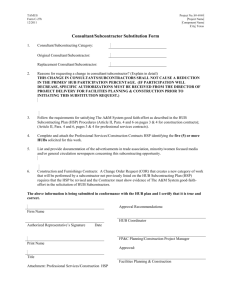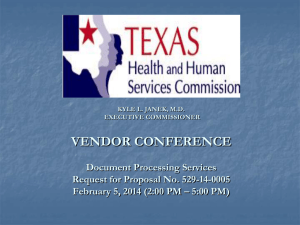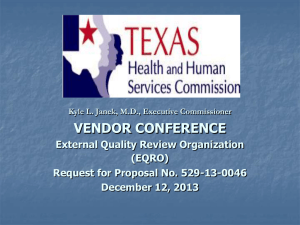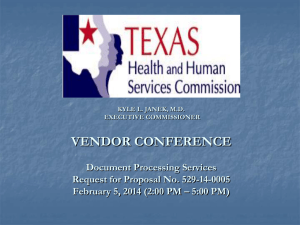Vendor Conference Presentation
advertisement
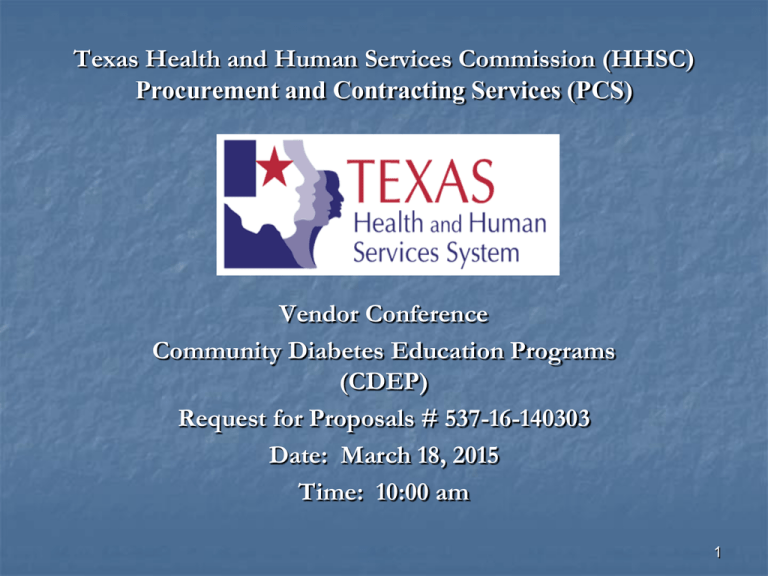
Texas Health and Human Services Commission (HHSC) Procurement and Contracting Services (PCS) Vendor Conference Community Diabetes Education Programs (CDEP) Request for Proposals # 537-16-140303 Date: March 18, 2015 Time: 10:00 am 1 Welcome Introductions Vonda White, HHSC Procurement and Contracting Services (PCS) Richard Kropp, Diabetes Prevention and Control Branch Manager, DSHS Carol Filer, DPCP Coordinator, DSHS Ashley Doyle, DPCP Program Specialist, DSHS Michael Herman, HUB Coordinator, HHSC Procurement and Contracting Housekeeping Items 2 HHSC Procurement Roles PCS- Responsible for procurement activity Program- Responsible for project scope, requirements, performance, results, contract management/monitoring HUB- Responsible for HUB activity 3 Vendor Conference Overview Procurement Activities Program Overview HUB Items Questions Submittal Break Preliminary Responses to Questions Closing Comments 4 Procurement Activities Sole Point of Contact – Section III.A. Questions & Answers – Section III.A. Solicitation Access http://www.hhsc.state.tx.us/about_hhsc/BusOpp/contract-opportunities.asp RFP Amendment and Announcements Submission Requirements – Section III.D. Evaluation Criteria & Screening – Section IV. Schedule of Events – Section I.D. 5 Schedule of Events RFP Release Date 03/06/2015 Pre-proposal Conference 03/18/2015 Deadline for Submitting Questions 03/23/2015 HHSC Post Answers to Vendor Questions 03/27/2015 Deadline for Submission of Proposals 04/06/2015 Post Tentative Award Announcement 05/26/2015 Anticipated Contract Begin Date 09/01/2015 6 Community Diabetes Education Programs (CDEP) Program Overview 7 Community Diabetes Education Programs (CDEP) Proposal Content Table of Contents and Checklist General Purpose and Program Goals (Scope of Work) SOW Background CDEP Goals and Implementation Performance Measures 8 Proposal Content Instructions for Preparation Confidential Information Table of Contents 9 Table of Contents and Checklist This form is provided as your Table of Contents and to ensure the proposal is complete, proper signatures are included, and the required assurances, certifications, and attachments have been submitted. Be sure to indicate page number. 10 Purpose and Program Goals SOW The TDPCP is the diabetes prevention and control program for the State of Texas. The vision of the TDPCP and the Texas Diabetes Council (TDC) is “A Texas Free of Diabetes and its Complications.” TDPCP goals address surveillance, health communications, health systems improvements, infrastructure, community intervention services, wellness, and health disparities. Increasing public awareness, promoting community outreach and diabetes education are TDC priorities. 11 Purpose and Program Goals SOW TDPCP follows the CDC National Center for Chronic Disease Prevention and Health Promotion’s framework. The four domains of this framework are: 1. Epidemiology and surveillance: Gather, analyze, and disseminate data and information; use results from evaluations to make decisions about prioritizing and delivering interventions; monitor programs and population health. 2. Environmental approaches: Promote health, and support and reinforce healthful behaviors statewide in schools, worksites, and communities. 3. Health system interventions: Increase the use and improve the effective delivery of preventive services and clinical care. This would help prevent disease, detect diseases sooner after onset, reduce risk factors, and control complications. 12 Purpose and Program Goals SOW 4. Strategies to improve community-clinical linkages: Ensure that communities support programs that improve management of chronic conditions and clinics refer patients to these programs. Specifically, this initiative is working to: Increase access and referrals to diabetes self-management education programs and reimbursement for this service; Increase pre-diabetes awareness Increase referrals to, use of, and reimbursement for CDC-recognized lifestyle change programs for the prevention of type 2 diabetes Increase use of health-care extenders (such as community health workers) in the community in support of self-management. 13 Purpose and Program Goals SOW TDPCP’s immediate outcomes for this project are: 1. Increased opportunities for physical activity and better nutrition. 2. Increased access to ADA-recognized and/or AADE-accredited diabetes selfmanagement education and support. 3. Capacity to collect and analyze data on waist circumference, BMI, tobacco status/cessation and blood pressure and other indicators listed on the sample participant health outcomes form in Appendix H as participants progress through interventions. 4. Improved capacity of a Community Diabetes Education Program (CDEP) advisory board to design, implement, and engage in program quality improvement of diabetes interventions. 14 Purpose and Program Goals SOW Additional project goals are to: 1. Increase public and provider knowledge of the symptoms, risk factors and target goals of diabetes, pre-diabetes and gestational diabetes management, and the importance of physical activity and healthy eating in preventing, delaying, or managing diabetes and its complications. 2. Increase health care provider, payer, and patient knowledge and use of the TDC’s Minimum Standards for Diabetes Care in Texas and treatment algorithms (www.tdctoolkit.org). 15 Purpose and Program Goals SOW Long-term outcomes for this project are: 1. Reduced risk of eye disease, kidney disease, nerve damage, and cardiovascular disease through diabetes self-management; 2. Reduced likelihood of costs associated with adverse health outcomes resulting from diabetes; 3. Reduced risk of developing type 2 diabetes through pre-diabetic lifestyle changes; and 4. Decreased undiagnosed cases due to better public awareness of diabetes risk in high-prevalence areas. 16 Background Recognizing that Texas includes many diverse communities with unique needs, the Texas Diabetes Prevention and Control Program (TDPCP) supports locally tailored programs. A program that is successful for one geographical area or ethnic group may or may not work for another area or group. The TDPCP has funded five previous cycles of programs developed by communities that deal with diabetes and health disparities, diabetes awareness and education, and changes in community systems, environments, policies and practices. These programs have demonstrated success in establishing culturallyappropriate programming for promoting wellness, healthy nutrition, physical activity, glycemic control, weight and blood pressure control, and tobacco cessation for persons with diabetes. Target populations include low socio economic status, racial and ethnic minorities with disproportionate rates of diabetes and those with limited access to health care services. In addition, these programs have trained community health workers and have worked to increase awareness of diabetes. 17 CDEP Goals and Implementation 1. Preventing type 2 diabetes in persons at high risk who do not have diabetes; and 2. Preventing complications, disabilities, and burden associated with diabetes. 18 Tier 1 and Tier 2 Refer to Appendix F Pages 120-123 19 Performance Measures Performance Measures (Tier 1) Performance Measures (Tier 2) 20 Tier 1 Performance Measure Guidelines (Tier 1) Pages 57-58 21 22 Form H: Performance Measures (Tier 1) The data entered on Form H: Performance Measures should be consistent with Form I: Work Plan Narrative (Part A), Work Plan Template (Part B), and Appendix J: Class Implementation Plan. Compare these documents prior to submission. 23 Tier 2 Performance Measure Guidelines (Tier 2) Pages 61-63 24 25 Form H: Performance Measures (Tier 2) The data entered on Form H: Performance Measures should be consistent with Form I: Work Plan Narrative (Part A), Work Plan Template (Part B), and Appendix J: Class Implementation Plan. Compare these documents prior to submission. 26 Appendix J: Class Implementation Plan The respondent must submit proposed diabetes self management education and support (DSME/DSMS) and diabetes prevention (DP) activities using the Excel spreadsheets. This workbook contains eight (8) separate worksheets. 27 The responses provided to Appendix J: should be consistent with Form I: Work Plan Narrative (Part A) and Work plan Template (Part B) and Form H: Performance Measures. Compare the documents prior to submissions. 28 HUB Subcontracting Plan (HSP) Requirements 29 HUB Topics I. RFP Section V-F Historically Underutilized Business Participation Requirements II. HUB Subcontracting Plan Development and Submission – Section 5.4 III. HSP Quick Checklist – Handout IV. HSP Methods – Section 5.6.3-5.6.7 V. HSP Prime Contractor Progress Assessment Report – Section 5.7 30 I. Historically Underutilized Business Participation Requirements 31 I. RFP Section 5.0 Historically Underutilized Business Participation Requirements • HUB Participation Goals – Section 5.3 • Potential Subcontracting Opportunities – Section 5.5 • Centralized Master Bidders List and HUB Directory – Section 5.5 • Vendor Intends to Subcontract – Section 5.6 32 I. RFP Section 5.0 Historically Underutilized Business Participation Requirements (cont.) • Minority or Women Trade Organizations – Section 5.6.6 • Self Performance – Section 5.6.7 • HSP Changes After Contract Award – Section 5.7 • Reporting and Compliance with the HSP – Section 5.7 33 II. HUB Subcontracting Plan (HSP) Development and Submission 34 If HSP is inadequate, response will be rejected HUB GOALS Special reminders and instructions HSP Information Page 35 III. HSP Quick Checklist ** See Checklist Handout** 36 IV. HSP Methods 37 METHOD OPTIONS A Respondent may choose from one of the following methods when completing the HSP: • Method I – if 100% of your subcontracting opportunities will be performed using only HUB vendors; • Method II – if one or more of the subcontracting opportunities identified will be performed using HUB protégé’s; • Method III – if a combination of HUBs and Non-HUBs are used to perform the subcontracting work identified AND the HUB goal identified in the solicitation is met or exceeded; 38 METHOD OPTIONS A Respondent may choose from one of the following methods when completing the HSP (cont.): • Method IV – if a combination of HUBs and Non-HUBs are used to perform the subcontracting work identified AND the HUB goal identified in the solicitation is not met or exceeded. • Method V - if the Respondent intends to self perform all of the work utilizing their own resources, equipment, employees, and supplies. 39 ALL METHODS For ALL Methods the following steps are required to be completed on the HSP Form: • Page 1 - Section 1 - Respondent and Requisition Information; • Page 2 - Company and Requisition Information • Page 2 - Section 2(a) – Subcontracting Intentions • Section 4 – Affirmation and Sign 40 HSP Information Page Respondent and Requisition Information 41 Company Name and Requisition # Subcontracting Intentions: If Yes, Complete Section 2a If No, Complete Section 2b 42 Section 4; Affirmation Signature Affirms that Information Provided is True and Correct. 43 METHOD I If all (100%) of your subcontracting opportunities will be performed using only HUB vendors, complete: • Section 1; • Section 2 b. – List all the portions of work you will subcontract, and indicate the percentage of the contract you expect to award to HUB vendors; • Section 2 c. – Yes; • HSP GFE Method A (Attachment A) – Complete this attachment for each subcontracting opportunity. 44 Complete Section 2-b; List all the portions of work you will subcontract, and indicate the % of the contract you expect to award to all HUBs. Complete Section 2-c; Yes if you will be using only HUBs to perform all Subcontracting Opportunities in 2-b. 45 HSP GFE Method A (Attachment A) Complete this attachment (Sections A-1 and A-2) and List Line # and Subcontracting Opportunity. HUB Subcontractor Selection for this Subcontracting Opportunity 46 METHOD II If any of your subcontracting opportunities will be performed using HUB protégés, complete: • Section 1; • Section 2 b. – List all the portions of work you will subcontract, and indicate the percentage of the contract you expect to award to HUB vendors; • HSP GFE Method B (Attachment B) – Complete Section B-1 and Section B-2 only for each subcontracting opportunity as applicable. 47 Complete Section 2-b; List all the portions of work you will subcontract, and indicate the % of the contract you expect to award to HUB Protégés. Skip Sections 2-c and 2-d. 48 HSP GFE Method B (Attachment B) Complete Sections B-1; and B-2 only for each HUB Protégé subcontracting opportunity. 49 HSP GFE Method B (Attachment B) List the HUB Protégé(s) 50 METHOD III If you are subcontracting with HUBs and Non-HUBs, and the aggregate percentage of subcontracting with HUBs in which the HUB Goal identified in the solicitation is met or exceeded , complete: • Section 1; • Section 2 b. – List all the portions of work you will subcontract, and indicate the percentage of the contract you expect to award to HUB vendors and Non HUB vendors; • Section 2 c. – No; • Section 2 d. – Yes; • HSP GFE Method A (Attachment A) – Complete this attachment for each subcontracting opportunity. 51 Complete Section 2-b; List all the portions of work you will subcontract, and indicate the % of the contract you expect to award to HUBs and Non-HUBs. Complete Section 2-c; No to using only HUBs to perform all Subcontracting Opportunities in 2-b. 52 Complete Section 2-d; Yes, to the Aggregate % of the contract expected to be subcontracted to HUBs to meet or exceed the HUB goal, which you have a contract agreement in place for five (5) years or less. 53 HSP GFE Method A (Attachment A) Complete this attachment (Sections A-1 and A-2) for each subcontracting opportunity. Subcontractor Selection (HUBs and Non-HUBs) 54 METHOD IV If you are subcontracting with HUBs and Non-HUBs, and the aggregate percentage of subcontracting with HUBs, holding an existing contract with HUBs for 5 years or less, does not meet or exceed the HUB Goal identified in the solicitation, complete: • Section 1; • Section 2 b. – List all the portions of work you will subcontract, and indicated the percentage of the contract you expect to award to HUB vendors and Non HUB vendors; • Section 2 c. – No; • Section 2 d. – No; • HSP GFE Method B (Attachment B) – Complete this attachment for each subcontracting opportunity. 55 Complete Section 2-b; List all the portions of work you will subcontract, and indicated the % of the contract you expect to award to HUBs and Non-HUBs. Complete Section 2-c; No, to using only HUBs to perform all Subcontracting Opportunities in 2-b. 56 Complete Section 2-d; No, to the Aggregate % of the contract expected to be subcontracted to HUBs to meet or exceed the HUB goal, which you have a contract agreement in place for five (5) years or less. 57 HSP GFE Method B (Attachment B) Complete Section B-1; and Section B-2 only for each subcontracting opportunity. Good Faith Efforts to find Texas Certified HUB Vendors 58 HSP GFE Method B (Attachment B) Written Notification Requirements List 3 HUBs Contacted for this Subcontracting Opportunity 59 HSP GFE Method B (Attachment B) Written Notification To Trade Organizations 60 HSP GFE Method B (Attachment B) List Trade Organizations Notified with Dates Sent/Accepted. 61 HSP GFE Method B (Attachment B) Provide written justification why a HUB was not selected for this Subcontracting Opportunity 62 METHOD V If you are not subcontracting any portion of the contract and will be fulfilling the entire contract with your own resources (i.e., equipment, supplies, materials, and/or employees), complete: • • All of the steps in Slides Section ; Section 3 – Self Performing Justification 63 Section 3; Self Performing Justification List the specific page(s)/section(s) of your proposal response, OR in the space provided, which explains how your company will perform the entire contract with its own equipment, supplies, materials and/or employees. 64 HUB Subcontracting Opportunity Notification Form 65 Sample for Respondent’s Use. 66 V. HSP Prime Contractor Progress Assessment Report 67 HSP Prime Contractor Progress Assessment Report • Required with ALL Pay Requests • List ALL Sub payments (HUBs & Non-HUBs) • Required even if not subcontracting 68 Texas Health and Human Services Commission (HHSC) Procurement and Contracting Services (PCS) Questions Submittal Followed by Break 69 Customer Relationship Management RFP Non-Binding responses to Vendor Questions Responses given at the Vendor Conference are non-binding verbal responses to vendor questions. Binding responses will be posted on the HHSC Contract Opportunity website by or around March 13, 2015. 70 Texas Health and Human Services Commission Closing Comments 71
